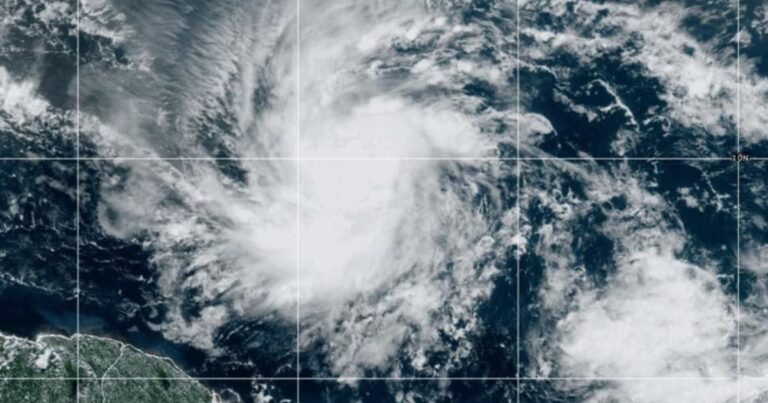Hurricane Beryl remains an “extremely dangerous” Category 4 storm as it makes landfall in the southeastern Caribbean, the National Hurricane Center said Sunday. Forecasters warned that the first major hurricane of the Atlantic season would bring life-threatening winds and storm surge to the Windward Islands early Monday.
As of 4 p.m. ET, Beryl was located about 250 miles east-southeast of Barbados, with maximum sustained winds of 130 mph and moving west at 18 mph.
Hurricane warnings have been issued for Barbados, Saint Lucia, Grenada, Saint Vincent and the Grenadines and Tobago. A tropical storm warning has been issued for Martinique and a tropical storm watch has been issued for Dominica and Trinidad.
“A very severe situation is developing for the Windward Islands,” warned the Miami-based National Hurricane Center, which said Beryl was “projected to become an extremely dangerous hurricane, packing life-threatening winds and a storm surge.”
Beryl is expected to pass the Windward Islands early Monday as an “extremely dangerous” Category 4 hurricane and move through the southeastern Caribbean late Monday night into Tuesday.
Two hurricane hunters were on the scene to gather more information on the storm’s strength, the National Hurricane Center said.
National Oceanic and Atmospheric Administration
Historic Hurricane
Hurricane expert Sam Lillo said it took Beryl just 42 hours to develop from a tropical storm into a major hurricane, a feat that has only been achieved six times in Atlantic hurricane history, with the earliest date being September 1.
Hurricane and storm surge specialist Michael Lawrie said Beryl would be the third Category 3 hurricane recorded in the Atlantic in June, after Audrey in 1957 and Alma in 1966.
“Beryl is an extremely dangerous and unusual hurricane for this time of year in this region,” he told The Associated Press in a telephone interview. “Unusual is an understatement. Beryl is already a historic hurricane, and it hasn’t even hit yet.”
Hurricane Ivan in 2004 was the last and most powerful hurricane to strike the southeastern Caribbean, causing devastation in Grenada as a Category 3 storm.
“This is a serious threat, a very serious threat,” Rowley said of Beryl.
Beryl is the second named storm in what is expected to be a busy part of the Atlantic hurricane season, which runs from June 1 to November 30. Last week, Tropical Storm Alberto bring up Severe flooding has hit parts of southern Texas and northeastern Mexico, killing at least four people in the Mexican states of Nuevo Leon and Veracruz.
CBS News forecaster David Parkinson said Beryl is the furthest east of any hurricane to form in June, and one of only two to form east of the Caribbean, the other being in 1933. Parkinson said he expects Beryl to remain south of Jamaica, and that it will be at least eight days before it impacts the United States.
Warmer waters are powering the beryl, with ocean heat content in the deep Atlantic reaching its highest level ever recorded for this time of year, according to Brian McNoldy, a tropical meteorologist at the University of Miami.
Forecasters warned that areas where Beryl makes landfall could experience life-threatening storm surges of up to nine feet, and up to six inches of rain could fall on Barbados and nearby islands.
Prepare for the storm
Chandan Khanna/AFP via Getty Images
Long lines formed at gas stations and grocery stores in Barbados and other islands as people rushed to prepare for the storm, which quickly intensified from a tropical storm with winds of 35 mph on Friday to a Category 1 hurricane on Saturday.
“We need to be prepared,” Barbados Prime Minister Mia Mottley said in a speech late Friday. “You and I know that when these things happen it’s best to plan for the worst and pray for the best.”
She noted that thousands of people were in Barbados on Saturday. Twenty20 World Cup Cricket FinalOn Saturday, India defeated South Africa in the capital Bridgetown in what is considered the biggest event in the world of cricket.
Meanwhile, St. Vincent and the Grenadines Prime Minister Ralph Gonsalves said in a speech on Saturday that evacuation centres would open on Sunday evening and urged citizens to prepare. He ordered staff to refuel government vehicles and asked grocery stores and gas stations to extend their opening hours ahead of the storm.
“Please take this very seriously and prepare,” Gonsalves said. “This is a terrible hurricane.”
Caribbean leaders were preparing not only for Beryl, but also for a series of thunderstorms that had a 70 percent chance of becoming a hurricane followed by a tropical storm.
“Don’t let your guard down,” Mottley said.
It is unusual for Beryl to reach hurricane strength, as the first hurricane of the season usually forms in early to mid-August, according to the National Hurricane Center. report A National Oceanic and Atmospheric Administration forecast released last month predicted this year’s hurricane season would be “above normal,” with 17 to 25 named storms, eight to 13 hurricanes, and four to seven major hurricanes of Category 3 or higher. An average Atlantic hurricane season produces 14 named storms, seven of which are hurricanes and three of which are major hurricanes.
A tropical storm is a tropical depression with maximum wind speeds of 39 to 73 mph, while a hurricane is To be defined It is classified as a tropical cyclone with maximum sustained winds exceeding 74 mph.

